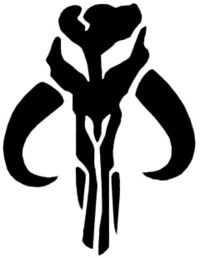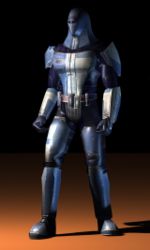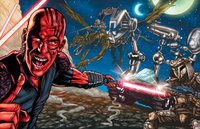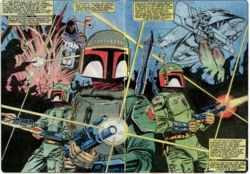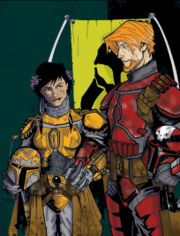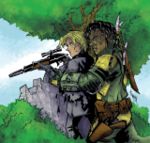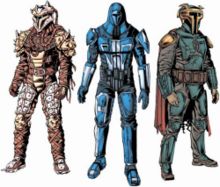Mandalorian 

From Wookieepedia, the Star Wars Wiki.
| |||||||||||||||||||||||||||||||
| [Source] | |||||||||||||||||||||||||||||||
- "Mandalorians don't make threats. We make promises."
- —Canderous Ordo
The Mandalorians (called Mando'ade in Mando'a, meaning "Sons and Daughters of Mandalore") were a nomadic nation of clan-based people consisting of members from multiple species.
Their culture revolved around that of battle and war being a source of honor and pride in their community. The leader of the Mandalorians typically took on the title of "Mandalore." Mandalorians were frequently allied with the Sith, most notably Exar Kun and much later as a prototype for the Clone trooper under the power of Darth Sidious and the Galactic Republic, though they would not hesitate to cooperate with the Jedi if it suited them.
In later years Mandalorian Warriors wore very distinctive battle helmets with T-shaped visors that covered the entirety of their faces. These helmets would eventually become strongly associated with the Mandalorian people.
Contents |
History
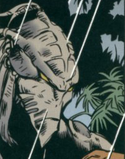
Early History
Originally, the Mandalorian clans were Taung from Coruscant, led by the warlord "Mandalore the First". Eventually they conquered a planet in the Outer Rim, which they named Mandalore after their leader. The Taung then took the name Mandalorians and were seen by many as the most skilled fighters in the Galaxy, thriving in battle. They were known for their use of cutting-edge weaponry and held to a strict code of honor. These Mandalorians wore crusader armor that differed from one soldier to the next.
For thousands of years after Mandalore's conquest, its new inhabitants would not venture far from the system they inhabited. It was not until the Great Sith War of 4,000 BBY that the Mandalorians would seek to expand their conquests and, in the process, become famous (and infamous) to the galaxy at large.
The Old Sith Wars
Almost three thousand years after the conquest of Mandalore, the Mandalorians wandered the Galaxy far from their home systems hoping to begin a new crusade against worthy foes. This brought them to the Empress Teta System during the period when the Krath had gained control of the system.
The Mandalorian clans became allied with the Sith after their leader, Mandalore the Indomitable, was bested in combat by the fallen Jedi turned Sith Lord, Ulic Qel-Droma. Mandalore pledged loyalty to Qel-Droma who in turn was apprentice to Dark Lord Exar Kun and in their name the Mandalorians laid waste to countless worlds in the years that followed, gaining the enmity of the Republic, and, most crucially, the Jedi.
Ten years after the defeat of Exar Kun, dozens of Mandalorians were unjustly arrested and executed after a psychotic bounty hunter named Jigger Wraith preyed upon innocents using rare Mandalorian weaponry.
The Neo-Crusaders were led by "Mandalore the Ultimate" and started the Mandalorian Wars. The Neo-Crusaders' armor was more advanced and uniform-like than their old armor. Canderous Ordo, who would later become Mandalore, wore a unique suit of silver and black armor.
After their defeat in the Mandalorian Wars at the hands of the Jedi Revan and Malak, the Mandalorians went into a long decline. Revan destroyed their stockpiles of weaponry and battle droids, and exiled the clans into the Outer Rim. One group settled on Tatooine, although their fate was unknown even several years later.
Some Mandalorians were unable to accept the terms of their defeat, and turned to piracy, brigandage, and mercenary work – e.g. Sherruk's group, who became bandits and troubled the settlers of Dantooine in 3,956 BBY. Canderous Ordo, who fought side by side with a redeemed Revan against Darth Malak during the Jedi Civil War, later claimed the rank of Mandalore and led a small remnant of his followers on the moon of Dxun. It was again Ordo, who traveled the universe with the Jedi Exile, and gathered the scattered Mandalorians who became mercenaries. Ordo was also a key in defeating the Sith Lord Darth Nihilus on the battleship Ravager.
The New Sith Wars
During the New Sith Wars, the Mandalorians would wage war against both the Jedi and the Sith. They opposed the mysterious Dark Lord of the Sith known as the Dark Underlord, having cut a deal with the Jedi Master Murrtaggh to assault the Dark Underlord's camp in a diversionary role, while Murrtaggh snuck into the fortress of the Sith Lord to slay him.
The Mandalorian distraction was successful: they engaged the Dark Underlord's Zeltron general and drew off his forces while the Jedi Master assassinated the dark side master, giving himself over to the dark side in the process.
A Mandalore during this era by the name of Ung Kusp was tricked into a war with the Sith; whether his war was the one against the Dark Underlord, and its result, are unknown.
Centuries later, Mandalorian armor was present at the Sith camp following the Battle of Ambria. Whether this meant that the Mandalorians had fought for the Sith at Ambria, that Mandalorians had attacked the Sith camp, or only that some Sith used captured or purchased Mandalorian armor, is unknown.
With the end of the wars, and the beginning of a thousand years of peace, the Mandalorians began to forget their warrior past, and, over the next few centuries, the Mandalorians slowly transformed into a less-clan based, more mercenary-orientated culture.
The Mandalorian Civil War
Some one hundred years before the Battle of Yavin, the leader of the Mandalorians was assassinated by the bounty hunter Durge. The Mandalorians struck back, and inflicted terrible tortures on the bounty hunter, but he managed to escape and entered into hibernation to heal his wounds.
In 60 BBY a schism occurred in their ranks. A violent splinter group, known as the Mandalorian Death Watch, revolted against the leadership of Jaster Mereel, who led the True Mandalorian loyalist faction, due to Mereel's proposed Supercommando Codex reforms.
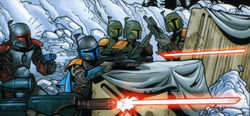
Eventually the civil war between these groups spilled over to the pastoral world of Concord Dawn. Here the Death Watch leader Vizsla attempted to murder Jaster. However, thanks to the assistance of a young orphan named Jango Fett, Jaster and his followers escaped the trap. Eventually, Vizsla caught up to Jaster and the Mandalorians on a distant world and, thanks to the treachery of fellow Mandalorian Montross, Jaster Mereel was killed in battle.
Jaster's protégé, Jango, took over the reins of leadership, despite Montross's disparaging comment that it would mean a "child leading them." Jango's tenure as Mandalorian leader ended at the Battle of Galidraan, where a Jedi task force under the leadership of Master Dooku led to the death of every remaining Mandalorian, except for Jango.
During this time, Mandalorians of an unknown faction massacred Ryyk's family.
After this disaster, the Mandalorians were effectively ended as a fighting force in the galaxy. Individuals survived on both Mandalore and in other isolated pockets of known space, but they played little influence on galactic affairs until the Clone Wars, when Jango Fett became the template for a Grand Army of the Republic on Kamino.
However, sometime before 32 BBY and while Palpatine was still a mere senator, the corrupt Governor of Mandalore, Vrox, started to send out members of the Mandalorian Armed Forces on sanctioned raids against worlds in nearby systems in order to plunder them and steal their riches. In addition to this, Vrox began producing outlawed battle droids, known as JU-9 Juggernaut War Droids.
The Republic soon sent a Republican Army task force along with several Jedi, including Voli Quana, to bring an end to the raids and stop the production of the droids. The ensuing battle was bloody, and once again ended in the near annihilation of the Mandalorian forces, as well as the capture of Vrox.
Clone Troopers
With Jango Fett being the clone donor, many elements of the Mando'ade culture made it into the Grand Army of the Republic ranks. This was boosted by the Cuy'val Dar, and Mandalorian training sergeants like Kal Skirata and Walon Vau.
Kal Skirata trained the Null ARCs, and they viewed him as a father. Kal taught the Mandalorian culture and language to the Null ARCs, as well as the Clone commandos. Eventually, the language and culture began to spread through the ranks of clones, and warrior chants like Vode An and Rage of the Shadow Warriors became commonly sung as a morale booster.
However, following the rise of the Galactic Empire, the transition of clone troopers into Imperial stormtroopers, the ranks of the troopers were joined with other clones and regular recruits. It is unlikely that the Empire continued to recruit former Mandalorians and Death Watch soldiers to train the clones of any template, thus future Fett clones grew up without their template's Mandalorian heritage and the once pure Jango Fett clone army lost its sense of being Mandalorian.
However, many retired clone commandos and troopers from the Clone Wars married and moved to one of the neighboring planets of Mandalore. Eventually, this planet was viewed as one of the homeworlds of the Mandalorians and was often used for training.
Rebirth of the Mandalorians
One clone trooper, an elite ARC trooper named Alpha-Ø2, ended up going rogue and changing the Mandalorians forever.
Because Jango took part in training the ARCs, Alpha-Ø2 had memories of Jango Fett. He went to Mandalore and started rebuilding the Mandalorian supercommandos into the Mandalorian Protectors from soldiers of local police forces and even former members of the Death Watch. Alpha-Ø2 became Mandalore the Resurrector, leading his men alongside the Confederacy of Independent Systems.
Among his troopers were Tobbi Dala and future Mandalore Fenn Shysa, both who believed Alpha-Ø2 to be Boba Fett, an unaltered clone of Jango. In 20 BBY, the Mandalorians were defeated at the Battle of New Holstice. Shortly afterwards, a number of them were massacred (apparently by their allies, the Geonosians for some unknown reason) at Zaadja. Near the end of the Clone Wars, the Mandalorians embarked upon a devastating blitzkrieg, attacking several important military targets, including Kamino and New Bornalex. Following the Mission to Norval II, only Spar, Fenn Shysa, and Tobbi Dala survived.
The Galactic Empire enslaved the planet Mandalore. Fenn Shysa and Tobbi Dala led a resistance group until 3 ABY, when Dala sacrificed himself to destroy the City of Bone and the Suprema. The Mandalorian people rallied behind Mandalore Fenn Shysa and rose up against Grand Admiral Miltin Takel.
The Mandalorians later assisted the Alliance of Free Planets during the Nagai-Tof Invasion following a Nagai attack on Mandalorian space, participating in space battle above Endor. The Mandalorians later helped the Nagai drive the Tof off Nagi. During the Battle of Mindor, Shysa's forces played a decisive role in defeating Lord Shadowspawn. Despite offers to join the New Republic, Shysa declined, choosing independence for his people.
The Future of the Mandalorians
Thirty years after the Battle of Yavin, the Mandalorians were now ruled by Boba Fett who succeeded Fenn as Mandalore. He trained his new Supercommandos on Raxus Prime, and decided to ally with the Yuuzhan Vong during the Yuuzhan Vong War. However, by the final year of the war, the Mandalorians had apparently come to the conclusion that serving the invaders was not in their best interests. Fett led his army against the Yuuzhan Vong in the Battle of Mandalore and the liberations of Gyndine and Tholatin (see Second Battle of Gyndine and Battle of Tholatin). He also led a small attachment with him to Caluula where he participated in the Battle of Caluula there saved Han Solo and Leia Solo.
Ten years later, Boba Fett, realizing he was dying, initiated the search for his successor to the rank of Mandalore. The search ended when Mirta Gev was revealed to be Boba's granddaughter. The two set out to restore the House of Mandalore and begin Mirta's training to become the next Mandalore.
Culture
- "In five millennia, the Mandalorians fought with and against a thousand armies on a thousand worlds. They learned to speak as many languages and absorbed weapons technology and tactics from every war. And yet, despite the overwhelming influence of alien cultures, and the absence of a true home world and even species, their own language not only survived but changed little; their way of life and their philosophy remained untouched; and their ideals and sense of family, of identity of nation, were only strengthened. Armor is not what makes a Mandalorian. Armor is simply a manifestation of an impenetrable, unassailable heart."
- —Passage from "Mandalorians: Identity and Language"
Mandalorian culture consisted of a very straight-forward nomadic society, influenced by many other cultures around the galaxy. As a whole, Mandalorians were not prejudiced of any species, but tolerated all Mandalorians, as long as they followed Mandalorian principles. Many war-orphaned children (such as Jango Fett and Mira) would be adopted into Mandalorian society, and brought up as Mandalorian children.
Mandalorian women were expected to have the same combat skills as men, in order to defend their homes when the men were away. If they didn't have children to raise, they fought alongside men on the battlefield. The ideal Mandalorian woman was physically strong and resilient.
The Mandalorians were nomadic warriors, despite the fact that they had the home world of Mandalore. The Mandalorians kept their nomadic ways so that in the event of attack, there would be no easy way to exterminate the Mandalorians. This attributed to the Mandalorians' survival over thousands of years. This also meant that many Mandalorians had never visited Mandalore.
Individual Mandalorians were independent warriors, bound together by the same culture. Each piece of Mandalorian steel was created, chosen and customized by a Mandalorian to their level of skill. The armor had great cultural significance for the Mandalorians, and each set told about the Mandalorian underneath. However, there was a saying in Mando'a: Verd ori'shya beskar'gam, meaning a warrior is more than his armor.
Not all Mandalorians constantly fought on the front line. There were farmers, regular factory workers, engineers, and doctors too. However, all Mandalorians were warriors at heart, and all knew how to fight.
Mandalorians were considered adults at an age as low as thirteen years, where their sons would take a trial turning them into warriors and men. This contributed to the fact that Mandalorians married and settled down earlier than most cultures. Family bonds were a large part of the Mandalorian culture, and as a result, they felt more comfortable around each other than they did around strangers.
Mandalorian weddings were brief and meant serious commitment and faithfulness to each other, making it a visual symbol of the loyalty that underlay the entirety of their culture. As such, infidelity was a great dishonor, and greatly marred the character of those who were involved in the eyes of the society.
There were six acts one needed to follow to be a Mandalorian, known as the Six Actions (Resol'Nare). They consisted of: wearing armor, speaking Mando'a, defending themselves and families, raising children as Mandalorians, helping the clan succeed and sustain itself, and when called to arms by the Mandalore, rally to his cause.
The only leader of the Mandalorians was the Mandalore himself, and he held his rank as long as he commanded the respect of his fellow warriors. In battle, Mandalorians would be assigned to different squads and jobs, depending on their area of expertise. The Mandalorians worked together to the best of their ability in battle. Mandalorians were not promoted to better jobs, since they did not have jobs—only in battle would some kind of organization need to occur.
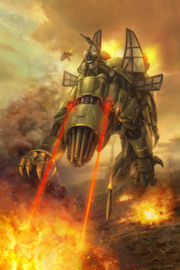
The only exception to this would be the way Jaster Mereel ran the Mandalorians. He often diverted from the culture of the Mandalorians, but only slightly so. His armor was different from everybody else's, which was gold and red, perhaps signifying rank. His second in command, Montross, wore silver and blue armor. This armor-rank system was carried on by Jango Fett, who wore Jaster's armor, and had his second in command, Myles, wear the blue-silver armor. Like Jaster, Jango did not act like a traditional Mandalorian.
Mandalorians had their own religion, the basic tenets of which have fluctuated over the centuries. At one time, Mandalorians were deeply religious beings, but the combination of disillusion with the old ways and the increasing warlike tendencies of the race led to a more pragmatic view of the galaxy around them.
Family was very important to the Mandalorians, yet when compared to most other cultures, they held very different beliefs as to what constitutes a familial relationship. Despite the fact that fidelity and chastity before marriage was highly emphasized, they were unconcerned about parentage. Believing that aliit iru'shya tal'din (Family is More Than Bloodlines), it was common for orphaned children, and even adults, to be brought into the culture.
Despite their rather gruff appearance and style of combat, the average Mandalorian was more sociable and kind than one would expect. As long as individuals spoke their mind, accepted a meal when offered, looked them straight in the eye (or the horizontal section of their visor), took off their boots when guests, paid their debts, fussed over their children, never made a pass at a Mandalorian of the opposite sex (unless the individual planned to become part of the culture) and respected the elderly, anyone who encountered a Mandalorian was not likely to end up on the business end of a blaster or vibroblade.
List of clans
Mandalorian worlds
Language
Mandalorians had a language distinct from Basic, known as Mando'a.
Behind the Scenes
- The Mandalorians on Dxun (in Knights of the Old Republic II: The Sith Lords) speak with a slightly Australian accent.
Appearances
- Tales of the Jedi: The Sith War
- Star Wars Knights of the Old Republic: Commencement
- Star Wars Knights of the Old Republic: Flashpoint
- Star Wars: Knights of the Old Republic
- Star Wars: Knights of the Old Republic II: The Sith Lords
- Jango Fett: Open Seasons
- Star Wars Galaxies: An Empire Divided (Mentioned only)
- Star Wars Episode V: The Empire Strikes Back novelization (First mentioned)
- Marvel Star Wars (First appearance)
- A Practical Man
- Revenants
- The Unifying Force
- Bloodlines
- Star Wars Legacy 4: Noob (Mentioned only) (Possible appearance)
Sources
- The History of the Mandalorians
- The New Essential Chronology
- The Mandalorians: People and Culture
- Underworld: A Galaxy of Scum and Villainy
- Star Wars Miniatures:
 Inside Mando'a Culture and Language on Hyperspace
Inside Mando'a Culture and Language on Hyperspace
 McQuarrie Mandalorian on Hyperspace
McQuarrie Mandalorian on Hyperspace







